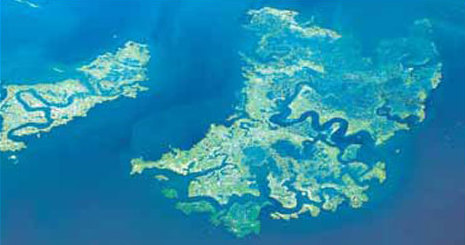Barriers that hold back the sea
Updated: 2013-11-24 07:04
By Henry Fountain(The New York Times)
|
|||||||||
When Typhoon Haiyan wailed through the Philippines on November 8, the storm surge it created raised the sea level by up to four meters in minutes, killing thousands of people and destroying nearly everything in the way.
Last year, Hurricane Sandy, which killed more than 100 people in America's Northeastern states, also produced a four-meter surge that left a trail of destruction, especially in Lower Manhattan.
When the floodwaters from superstorms like these recede, suggestions pour in for ways to keep populated, low-lying areas safer.
|
Two salt marsh islands in Jamaica Bay, New York, where work is being done to restore wetlands that might serve as natural storm barriers. Aerial Image by Pictometry |
After Sandy, higher flood walls and more bulkheads were called for by some. Other experts backed even bigger engineering projects, like storm-surge barriers.
But the most intriguing suggestions involve natural approaches. In New York's case, some argued, why not return the city to its days as an oyster capital, and build reefs in the harbor that could help beat down a storm's waves? Why not turn Lower Manhattan into an aquatic paradise, fringing it in marshland that could reduce surging storm waters?
"A lot of people want wetlands to be a solution, instead of walls," said Philip Orton, a research scientist at the Stevens Institute of Technology in New Jersey. "It's a warm and fuzzy thing."
But natural features are an uncertain solution. While some natural barriers like dunes have been shown to be effective at absorbing storm energy - during Sandy, shore towns with dunes suffered less damage generally than those without - it is less clear that marshes, oyster reefs or kelp beds provide much protection. Interactions between a storm and natural features are complex, and the dynamics of every storm are different, scientists say, making protection difficult to quantify.
"There's a lot of people saying that wetlands can reduce storm surges," said Rusty Feagin, an ecologist at Texas A&M University. "There isn't a lot of empirical evidence on it."
Proponents of a natural approach say their research shows that wetlands and reefs can offer some protection, especially from waves. They note that engineered solutions like sea walls have their own problems - for one thing, they can worsen flooding and erosion elsewhere.

And marshes and oyster beds provide other benefits to ecosystems. Marshes can keep up with rising sea levels brought on by climate change, because as the marsh grasses slow down water, sediment carried by the water settles out, building up the soil. And oysters filter impurities, improving water quality.
But even the strongest proponents of natural defenses acknowledge their drawbacks.
"All of these have their limitations, but they can provide some risk reduction," said Nicole P. Maher, senior coastal scientist with the Nature Conservancy on Long Island who studies Jamaica Bay in New York and other wetlands. "But once you get really deep water, it doesn't matter if it's a parking lot or an oyster bed or a salt marsh."
If a marsh or reef is effective in reducing storm surge, it is because it dissipates energy as water moves over grasses, roots, oyster shells and other materials, generating friction.
"It's definitely out there that wetlands are barriers," said Dr. Orton. "But that's really only true if you have a lot of space."
Narrow strips of marshland, as have been proposed for some areas around Lower Manhattan, would have almost no effect on storm surge. And much of the rest of the New York area is so developed that there are few large expanses of wetlands to buffer storms. But an area like Jamaica Bay, which stretches for nearly 16 kilometers, might offer some protection, Dr. Orton said, particularly if it was restored to historical conditions, before shipping channels were dredged.
And even if a narrow strip of marshland would have little impact on storm surge, it could reduce wave energy in a storm, said Joannes J. Westerink of the University of Notre Dame in South Bend, Indiana. "The scales of motion are much smaller" with waves, he said, and even if the wetland were overrun by storm surge, it would "attenuate waves very effectively."
"And," he added, "waves can knock the socks off your infrastructure."
The New York Times
(China Daily 11/24/2013 page11)
